What features does artesian water have in the Moscow region? This makes it possible to identify the quality of a given aquatic environment. Features of groundwater layers in the Moscow region. What is the composition of the artesian waters of our region? Analysis of water components from artesian formations, assessment of their impact on humans. What factors influence the quality of artesian waters in the Moscow region. Artesian water in the Moscow region has a high content small particles sand and clay. Quality analysis often shows that the permissible concentrations of ammonia, fluorine, hydrogen sulfide and manganese are exceeded.
Features of groundwater in the Moscow region
In our region, consumers have access to several types of groundwater located at different depths:
- Groundwater environments. These are the layers closest to the earth's surface.
- At a greater distance from the earth's surface there are ancient aquifers of the Jurassic-Cretaceous period.
- Even lower are the aquifers Carboniferous period. They are the purest because they are isolated from external factors. These layers contain the best artesian water, since the level is located at a considerable distance from the lower overly mineralized horizon.
- The deepest aquifers, characterized by a high degree of saturation with minerals.
The purity and quality of water in the first two layers are very dependent on external man-made factors. Often they are polluted by sewage and surface water. This is especially noticeable during the flood period and during the autumn rainy season.
Artesian water: quality
Artesian water in the Moscow region has a high iron content and high hardness. Many are familiar with such a situation when the crystal pure water, just taken from the well, becomes brown and cloudy right before our eyes. This occurs due to the oxidation reaction of iron dissolved in water when interacting with oxygen.
Current standards for drinking water limit the iron content in this aquatic environment to 0.3 mg/l. Artesian waters of the Moscow region are characterized by an increased concentration of this element ranging from 0.5 to 20 mg/l.
As for water hardness, according to regulatory documents this indicator should not exceed 7 mol/m³. Artesian water in the Moscow region is characterized by a hardness level of 3-10 mol/m³. This suggests that the aquatic environment has an increased content of sulfates and dissolved calcium and magnesium salts.
In addition, water from an artesian well in this region is characterized by a high content of impurity particles. In this case, these are small particles of clay and sand. Also, an analysis of artesian water in certain regions of the Moscow region revealed an excess of the concentration of some chemical substances, namely:
- fluorine particles;
- ammonia elements;
- manganese;
- hydrogen sulfide.
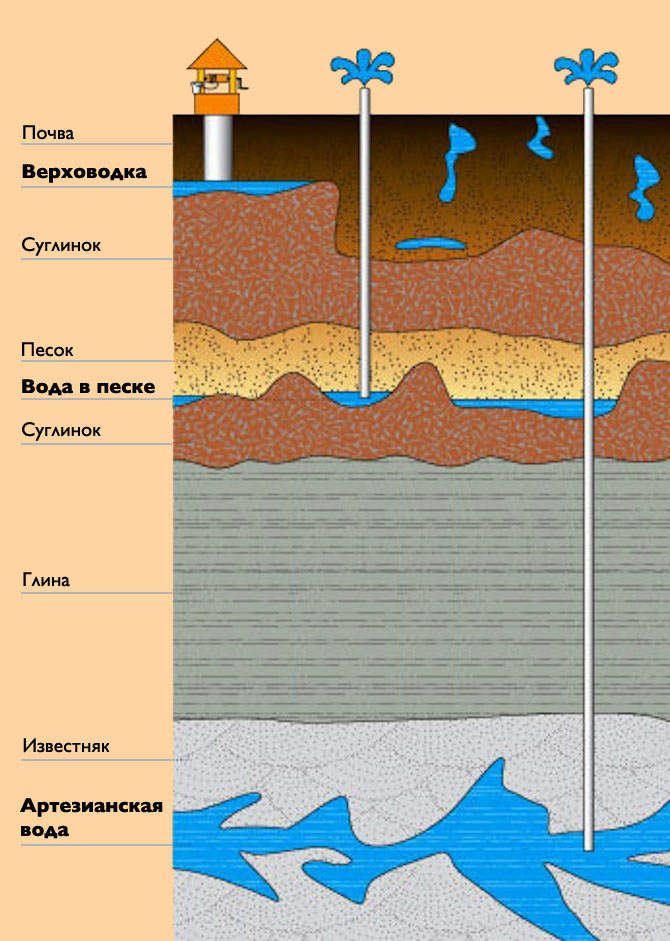
Features of the artesian water basin of the Moscow region
The artesian waters of this region are often classified as carbonate. The aquatic environment is usually fresh with a degree of mineralization equal to 0.4-0.6 g/l. The quality of these waters is usually very good, especially for waters of the hydrocarbonate and magnesium-calcium groups.
However, some layers of artesian waters are polluted from upper aquifers (groundwater). Their aquatic environment is the same, fresh. The environment of these contaminated horizons is characterized by the presence of chlorides and bicarbonates, as well as increased hardness due to the high concentration of sodium, magnesium, and calcium. The composition of this artesian water is not very good, so it needs to be thoroughly cleaned before use.
Analysis of underground artesian waters
Artesian water of the highest category must meet the requirements of regulatory documents. The main maximum permissible concentrations of substances for such waters are standardized in GOST 17.1.1.04-80. On chemical composition Artesian waters are influenced by the following factors:
- Features of water horizon nutrition.
- Constituents of surrounding rock layers.
- Degree of protection against pollution wastewater, aqueous environment from other layers.
Analysis of artesian waters in the Moscow region showed the following features of the aquatic environment:
- The concentration of dissolved mineral components is exceeded and amounts to 20 mg/l.
- The concentration of hydrocarbonates is also higher than normal, which creates an aquatic environment with increased alkalinity.
- Due to an excess of calcium and magnesium salt compounds, the aquatic environment is characterized by increased hardness. Normally, this indicator should be equal to 2.5-3 mg/l, and in the aquatic environment under study it is equal to 4.3-5.6 mg/l.
- During the analyses, a low concentration of chloride particles and sulfate elements was detected.
- Due to the fact that these aquifers are surrounded by rock with a certain celestine content, strontium is found in the water. Typically its concentration is 2-5 mg/l. This number increases as the aquifer sinks.
- According to SanPiN 2.1.4.1074-01, artesian drinking water should have a concentration of iron no higher than 0.3, and magnesium particles no higher than 0.1 mg/l. In the analyzed aquatic environment, these indicators significantly exceeded the norm. In principle, these water components, even in large quantities, are not harmful to humans, but they contribute to the development of ferrous bacteria, which cause increased corrosion of pipelines. To purify artesian waters from these components, the aeration method is used.
- An increased concentration of fluoride particles in artesian water can lead to problems with bone tissue, so this aqueous environment is purified by filtration through sorbents.
- Exceeding the concentration of hydrogen sulfide in the artesian aquatic environment leads not only to a deterioration in the organoleptic properties of water, but is also harmful to humans. The concentration of this substance is limited by regulatory documents and should not exceed 0.003 mg/l.
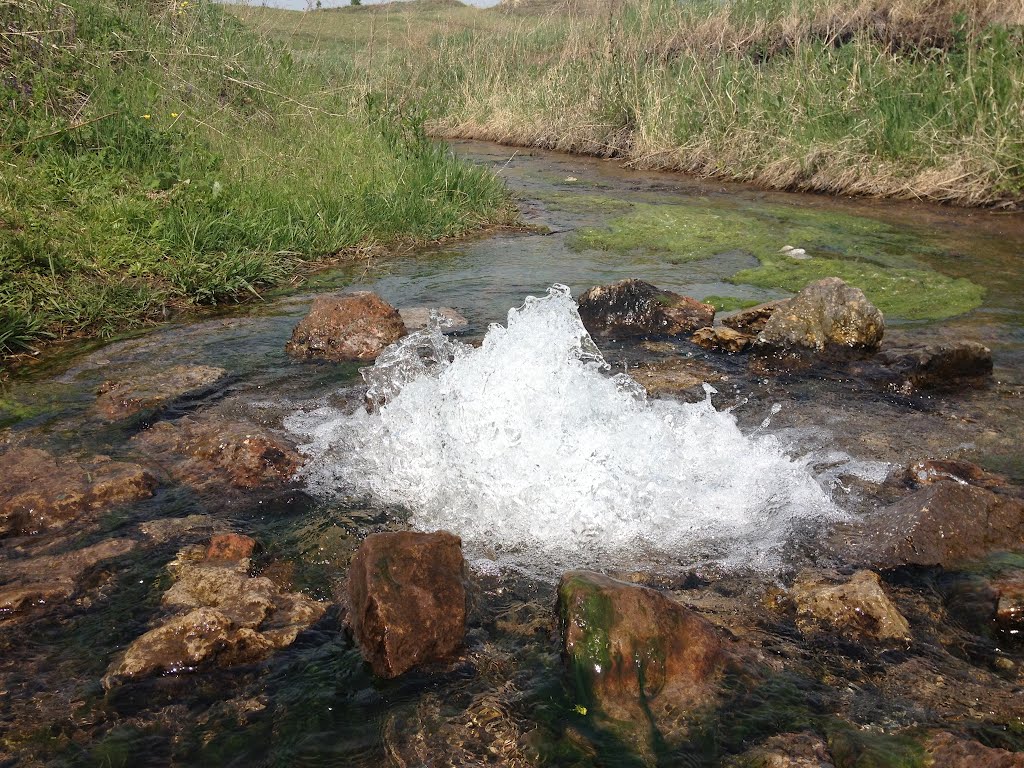
To draw conclusions about the purity and quality of artesian water, it is necessary to conduct a laboratory analysis. You can order such a check in our independent laboratory. To do this, you need to contact us by phone listed on the website. The price of the test depends on the number of components analyzed and is specified when ordering.
Water from an Abyssinian well is usually clean and high-quality water. The recharge zone of this water is located over a vast territory. That is, precipitation can nourish it many kilometers away from you, it gradually migrates underground - and you pump it out on your site.
In terms of mineral composition, this water is distinguished by a low content of hardness salts, manganese and other elements.
Bacterial contamination is also extremely low, since sand is an excellent bacterial filter; sand adsorbs a huge amount of organic matter. Sand is also used in backfill filters and water clarifiers. Unlike a conventional well, water from an Abyssinian well is taken from the depths, so it does not receive the perched water inherent in some wells made of concrete rings.
the only headache water from a needle driven well in some regions is iron. IRON IS NOT PRESENT IN WATER EVERYWHERE, IT IS DIFFERENT IN EACH LOCATION. The iron content of water from different aquifers may differ!
For example, the 1st water is good, but is located too close to the surface, the 2nd water is red, the 3rd is good.
Unfortunately, it also happens that in a given area there is only one aquifer vein - and the water in it is red or turns brown over time. In our practice, each well is individual!
This is the situation, for example, in the Moscow region - in one village the water from Abyssinian wells is clean, in another it is ferruginous.
And in the Stavropol region, for example, all the water is good, but in order to break through it with a spear from an Abyssinian well, you need to break through a significant layer of brown clay.
Quality of water from an artesian well
Water from deep artesian wells, on the contrary, contains a large number of hardness salts, iron in dissolved 2-valent form, manganese and other elements that dissolve in water. Divalent iron is soluble iron; when exposed to air in such water, iron transforms into the trivalent form and precipitates. This manifests itself as rusty flakes, the water turns brown, and sediment appears. But again, this is not everywhere!
In practice, there are such cases:
- They plugged the Abyssinian well - the water in it is clean and good. The neighbors drilled an artesian well - the water in it is ferruginous.
- The Abyssinian well was clogged - the water in it was ferruginous. We drilled an artesian well - the water is clean. And it doesn’t turn brown in the air.
In general, there are many situations.
But in general, water from Abyssinian wells has proven itself to be excellent! And if the soil on your site allows you to make an Abyssinian well, then it’s definitely better to make one!
Well water is not always clean, healthy and tasty. It may contain foreign impurities, pathogenic bacteria and even toxic substances. Only a detailed analysis of water from a well will help you find out whether the “extracted” liquid is suitable for drinking and household needs. If the results of the study turn out to be unsatisfactory, this is a reason to take a closer look at the issue of its purification and filtration.
A person is 70% water, so its impact on our health is colossal. Consumption of low-quality liquid leads to a decrease in immunity and greatly increases the risk of various viral, bacterial and allergic diseases.
In addition, the use of contaminated water at home is fraught with damage to expensive equipment (dishwashers and washing machines, boilers, kettles), clogging of pipes, and the appearance of unpleasant, difficult-to-remove deposits on plumbing fixtures. Therefore, to preserve your own health and the contents of your wallet, it is very important to understand what kind of water flows from the taps in the house.
Even the purest, at first glance, water can contain a lot of harmful impurities. The absence of cloudiness, odor or unpleasant taste does not guarantee the safety of the liquid
Water testing: when and how
Laboratory methods of testing water from a well are carried out to determine its potability. In some cases, experts strongly recommend their implementation. Good reasons include:
- Sale of country real estate. The conclusion of experts about the high quality of water on the site greatly increases its attractiveness in the eyes of buyers when selling.
- Buying land. Having purchased land plot, it is necessary to carry out a water analysis to be sure of its safety.
- The occurrence of health problems. The increase in the number of colds and gastrointestinal disorders can be directly related to the presence of harmful impurities in drinking water.
- Desire to purchase a water purification system. To select the optimal filtration unit, it is imperative to find out the degree of contamination of the liquid.
It is mandatory to conduct a water analysis in case of deterioration in its organoleptic characteristics - color, taste, smell, transparency. If the color changes upon contact with air: it turns yellow or even turns brown, stains remain on clothing and plumbing fixtures, it most likely contains an increased concentration of iron.
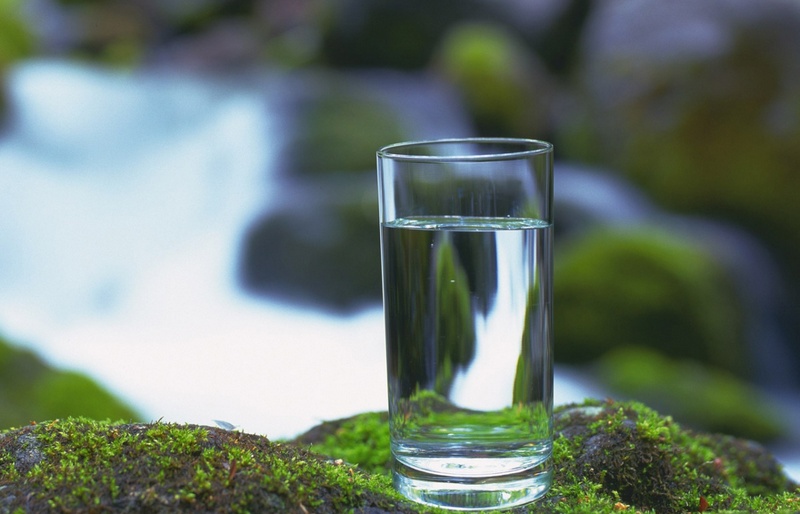
High-quality water contains up to 25% of the daily dose of magnesium, up to 20% calcium, up to 70% fluorine, and up to 50% iodine. The purity of such a valuable source of useful elements cannot be neglected
The smell of rotten eggs coming from the liquid indicates an excess of hydrogen sulfide. Under no circumstances should you drink such water, as it can be toxic. Increased mineralization gives the liquid a salty taste. Constant consumption of water with a large amount of sodium ions can aggravate the course of hypertension, and, in general, is not good for health.
The appearance of muddy water in a well - this may indicate both mechanical contamination of the fluid and chemical and biological “problems” of the source.
The quality of drinking well water should be assessed regularly - at least once every 1-2 years. The composition of water changes periodically - both due to natural climatic reasons (flood, drought) and due to human fault. Chemical wastes and toxic substances seeping into the soil can penetrate into aquifers, and these changes, unfortunately, are not noticeable to the naked eye. Therefore, you should always “keep your finger on the pulse” by periodically checking the composition of the water you consume.
Image gallery


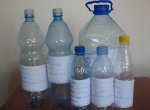
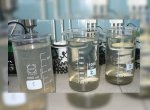
As for assessing the quality of water in a new well, there is definitely no need to rush here. It is recommended to thoroughly wash the excavation and wait 3-4 weeks, when the contamination caused by the installation work will disappear on its own.
Where is the best place to do the analysis?
There are many laboratories that carry out water research. But preference should be given exclusively to trusted companies that have licensed confirmation of the right to conduct analyzes. Experts recommend contacting only large companies with many years of experience in this service area. Don't be tempted by the low price; you should focus only on the quality of work and real reviews clients.
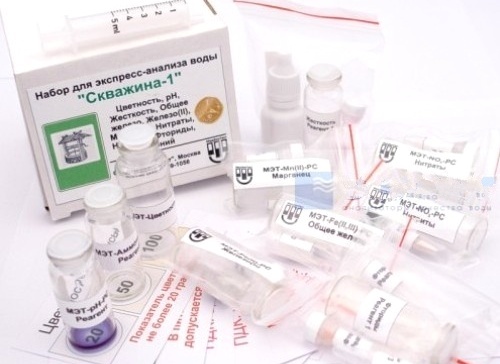
You can also evaluate the quality of water from a well at home. To do this, you need to purchase a special kit for express analysis. True, it will be possible to study a very small number of indicators
When contacting small companies, it is worth considering the fact that they are often intermediaries and do not have their own laboratories, i.e. “redirect” samples for analysis to other offices. In this case, you can’t count on getting results quickly. Therefore, when choosing a laboratory, always ask whether the company has its own resources to perform necessary analyzes, as well as a license with the right to conduct research.
Testing stages and costs
The first stage of the study is competent water sampling. This process can either be entrusted to laboratory staff or performed independently. In the second case, it is very important to pay attention to the following points:
- It is advisable to take water containers from the laboratory.. The one where the analysis will be performed. These containers have passed special treatment, they contain preservatives that ensure stability of the chemical composition of the liquid. Using glassware prepared by the laboratory is the key to obtaining the most reliable test results.
- Laboratory containers should not be rinsed. You should also not drain water from them and refill them.
- Use clean containers. If it is not possible to take vials to the laboratory, you can use clean glass or plastic container from drinking water.
Please note that sweet drink containers that have not been treated with copious amounts of running water, are absolutely not suitable! Sampling for the content of petroleum products, fats and other organic indicators should be carried out in dark glass containers.
Self-sampling of water significantly reduces the final cost of the study, but carries the risk of distorting objective data if the process is neglected. Therefore, be sure to follow following rules sampling:
- All manipulations should be carried out with clean, thoroughly washed hands with soap.
- Own dishes for delivering water to the laboratory must be absolutely clean and free of foreign odors (the optimal container capacity is 1.5-2 liters). Before filling, it should be rinsed three times with the water to be analyzed.
- Time to drain water from autonomous water supply should be at least 5 minutes before sampling.
- Filling the container must be carried out in a thin stream along the wall of the container. Do not change the water pressure by opening or closing the tap.
- The container should be filled with water to the top (under the very lid): air in the container can affect the test results.
- Bottles with water must be signed - indicate the time, place and date of sampling.
- It is very important that samples reach the laboratory without delay - no later than 2 hours after collection. If prompt delivery is not possible, the sample should be refrigerated. This will increase the “shelf life” of the selected water to 12 hours.
To assess the quality of well water, Various types analyzes - chemical, organoleptic, microbiological, advanced. The cost of the study depends on the number of indicators determined and the set of additional services. On average, a standard analysis will cost 1500-2000 rubles, a full one - 4000-5000 rubles.

There is no doubt about the results of water analyzes from a well, carried out in accordance with all the rules by an accredited laboratory. The research will be carried out clearly and promptly
All standards that water must meet private system water supply, established in section 4 of SanPiN 2.1.4.1175-02. Among the mandatory indicators for assessing liquid quality:
- smell;
- color;
- turbidity;
- taste;
- pH value (pH);
- nitrates;
- general hardness;
- permanganate oxidation;
- general mineralization;
- chlorides;
- sulfates.
If you regularly submit water for testing, you can limit yourself to analysis using a basic list of indicators, including only those “points” for which exceedances of permissible values are most often recorded (pH, hardness, odor, iron, manganese, permanganate oxidation, total mineralization).
Such an analysis will make it possible to draw general conclusions about the quality of well water, but will not make it possible to assess its overall compliance with established standards.
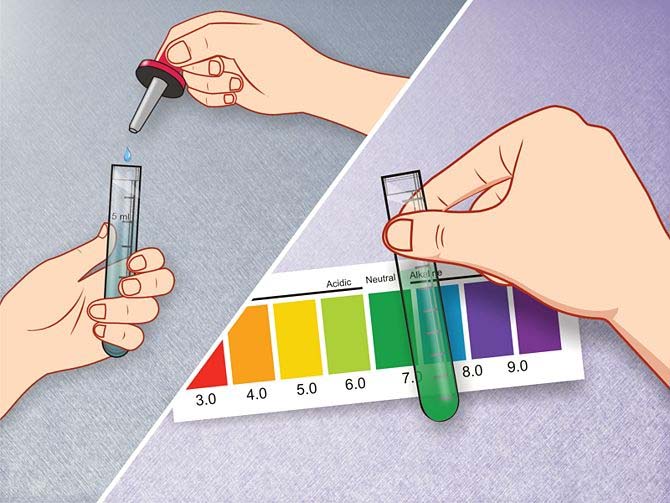
A deviation of the pH level up or down from the norm affects the visual condition, taste and smell of water. The effectiveness of water treatment measures also largely depends on the pH level.
Microbiological examination of the liquid is carried out according to the following indicators:
- total microbial count;
- common colimorphic bacteria;
- coliphages;
- thermotolerant colimorphic bacteria.
You can get test results from most large laboratories within 2-5 days. Small firms cope a little slower - they need 7-14 days to prepare a research protocol.
Well water treatment methods
Test results that fit all norms are excellent. In this case, you don’t have to worry about special additional filtration of the liquid. But if foreign impurities or dangerous concentrations of elements have been identified in the water, you must take care of its high-quality purification.
Image gallery
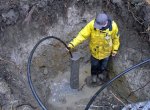

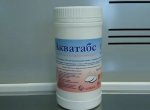
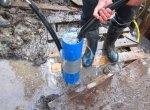
Usually water is purified in several stages. Their number is determined by the degree and types of pollution. A complete well water purification scheme consists of the following elements:
- a “coarse” cleaning module consisting of one or more filters;
- iron filter;
- softener;
- carbon filter;
- disinfectant;
- installation for fine purification (preparation of drinking water).
The more levels a water treatment system has, the more best quality water is obtained at the outlet. However, you shouldn’t “overload” your wallet by purchasing the entire arsenal of cleaning devices - you need to solve real problems, confirmed by test results, and not “fight with windmills.”
Features of rough cleaning
This stage of water treatment is necessary to remove mechanical suspension from the liquid (large particles of clay and sand, rust, silt, scale). Properly selected coarse filters ensure the uninterrupted operation of finer filters (they are installed at the beginning of the water treatment system). The liquid is purified from large impurities by passing it through a system of meshes.
From time to time, mechanical filters become very dirty and require washing. To get rid of the need to dismantle the elements and stop the water supply at the same time, it is recommended to install self-cleaning filters - they are cleaned by a jet stream. A reliable choice would be devices from Honeywell (USA) or Drufi (Germany).
Softeners to solve the problem of hardness
A high concentration of magnesium and calcium salts makes water hard. Such water adversely affects the operation of plumbing equipment, as well as electrical appliances that use water. Deposits on heating elements (scale), limescale on pipes, shut-off valves, shower head nozzles, etc. - only a small part of the possible consequences.
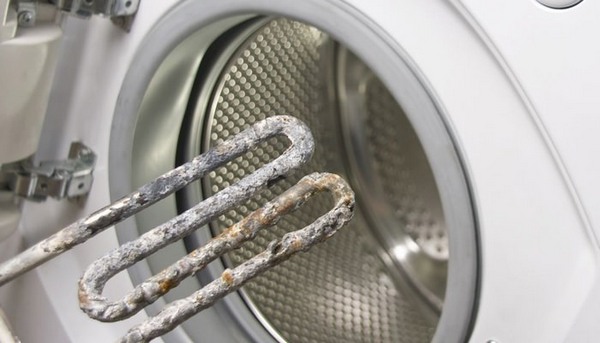
Too hard water in the well can damage household and kitchen appliances. Installing a softener filter will save you from unexpected expenses
Well water softening is a task that can be solved in several ways. It is cheaper to do this with equipment that uses the method of proportional dosing of a special reagent that neutralizes hardness salts. Such devices (for example, Quantomat from BWT) are a flask with a dispenser filled with a reagent.
The portions of the reagent measured by the dispenser depend on the volume of water passing through the neutralizer. Unfortunately, this method does not allow us to talk about full-fledged softening of water, since magnesium and calcium salts are not removed from the liquid, but are only “deactivated”.
Only complex installations can provide complete softening, the operating principle of which is based on ion exchange - the replacement of calcium ions with sodium ions. To do this, the liquid comes into contact with an ion exchange resin. The source of sodium ions is a solution of table salt. Such equipment is quite expensive, but its use in country house for drinking preparation of well water is quite justified.
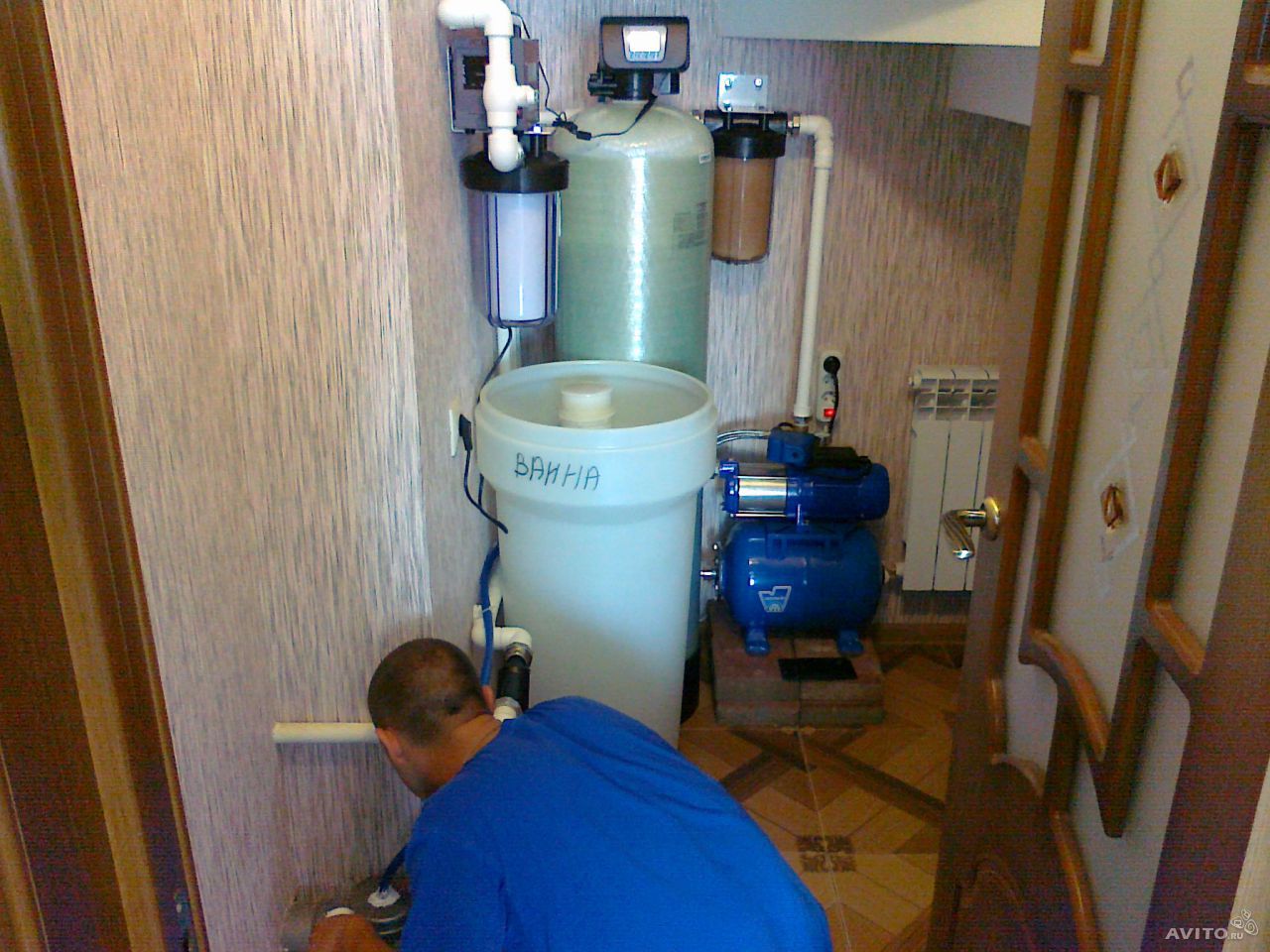
Sometimes softener filters can also be used to remove dissolved iron from water, but it is still better to use a special iron removal unit for these purposes.
The importance of using iron removers
Iron is often not associated with ordinary person with a poisonous substance. Therefore, many simply ignore the need to deferrize well water. But in vain. An excess of this element in drinking water can provoke whole line internal diseases and general debility.
Iron removal from water is carried out by special filters, the operating principle of which is based on the transformation of iron from a soluble form into an insoluble precipitate through its oxidation. Oxidation of iron dissolved in a liquid can be carried out reagent-free (artificial or natural aeration) and reagent-based (using “powerful chemistry”).
The operating principle of reagent-free pressure units is as follows: forced saturation of water with oxygen occurs in a special aeration column located directly in front of the filter. The compressor pumps air there, the iron is oxidized and it precipitates. The sediment is retained in the thickness of the filter loading.
During the aeration of water, in addition to the oxidation of iron, a number of useful processes take place. In particular, the removal of hydrogen sulfide, a dangerous and toxic substance, having the smell of rotten eggs. The removal of hydrogen sulfide occurs through an electromagnetic discharge valve located in the upper part of the column.
The cost of pressure iron removers is quite high, but this is fully justified by low operating costs and ease of maintenance.
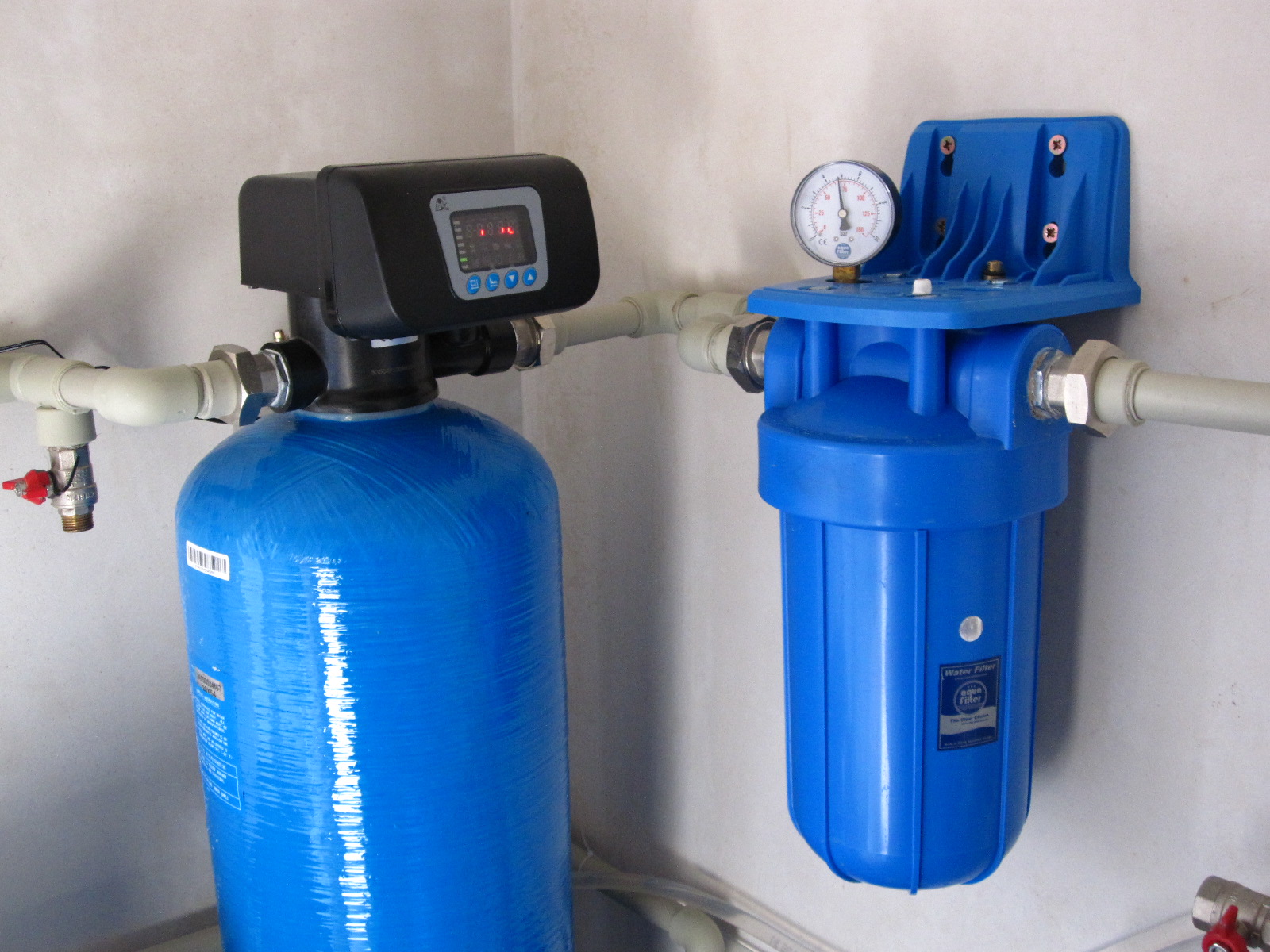
Modern filters for deferrization of water from a well in a country house are designed for efficient and uninterrupted operation for many years.
In reagentless type devices with natural aeration, the oxidation of iron occurs in a storage tank. This process takes much longer than with artificial air saturation. There is no compressor here. After oxidation, the pump pumps water directly into the iron remover.
Reagent-type filters remove iron using a catalytic method. The oxidation of the element occurs on the surface of the granules of a special medium with filtering abilities, the retention of the formed compounds occurs in its thickness. Such systems are highly efficient and compact; they are cheaper than reagent-free analogues, but require regular expenses for the purchase of reagents.
Disinfection of water from a well
Disinfectants are usually used at the final stage of water treatment. The main task of this equipment is the destruction of bacteria and other microorganisms. The most common are ultraviolet sterilizers. The disinfecting effect is achieved through a series of photochemical reactions. UV filters do not require any complex maintenance, they only need to periodically change the lamp.
It is important to note that the chemical composition of water does not change during the “sterilization” process.
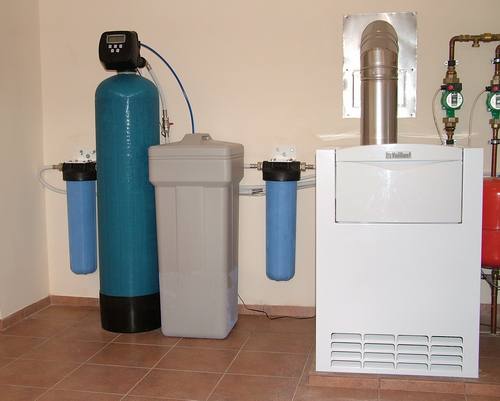
Independent preparation of the “configuration” of the cleaning system is only possible if you have special knowledge in the field of hydrochemistry. Otherwise, it is better to entrust this issue to professionals
Reverse osmosis plants: drinking water treatment
Most effective method obtaining water with drinking parameters - its purification with reverse osmosis units. In this case, the liquid is passed through a special membrane that retains absolutely all foreign impurities. The quality of water at the output of reverse osmosis systems is the highest possible, meeting the most stringent requirements.
The only drawback of reverse osmosis purification is the absence of mineral composition. Special salt cartridges solve the problem. This equipment is quite compact; it fits easily under the kitchen sink.
Useful videos on the topic
A convincing argument for the importance of analyzing well water:
Review of the well water purification system in the cottage:
Advantages of water treatment using reverse osmosis units:
It is absolutely obvious that periodic research of the chemical and microbiological composition of water should under no circumstances be neglected. Contaminated liquid poses a very real threat to health, and it is very naive to believe that Borjomi is “flowing” from your well. The vast majority of sources require water treatment to one degree or another.
Properly selected filters will help cope with any contamination and make the water truly clean and healthy.
Artesian wells take water from limestone aquifers. But, despite good natural filtration, although its water is the cleanest compared to other sources, it still has some contaminants.
Where do foreign impurities come from in well water? Let's try to figure out what exactly affects the quality of artesian water.
The main factor in groundwater pollution is its contact with a mixture of sand and clay, the so-called Quaternary sediments. A layer of these sediments lies directly above the limestone aquifer. The limestone has small cracks through which the waters of Quaternary sediments penetrate into the horizon, introducing iron (up to 10 mg/l) into its water.
The next thing that can cause contamination of artesian water is the violation of well drilling technology. One of the mistakes when drilling is pairing horizons - when between the upper aquifer and the limestone horizon lacks tightness.
Water quality requirements and standards
There are special standards that specify the requirements for the quality of water from underground sources. Thus, such water should contain no more than 1 mg of iron per liter, no more than 500 mg/l of sulfates, and no more than 7 mEq/l of total hardness. There are such requirements for many chemical elements, compounds, and even for the number of microorganisms in 1 liter of water there are standards. Compliance with drilling technology and the hydrogeology of the area greatly contributes to the reduction of impurities in well water.
For example, knowing that the content of minerals and fluorine in water increases as the horizon “falls” deeper, you should drill water wells in the area under which the aquifer lies closer to the surface, unless, of course, this does not disturb sanitary norms(location of cesspools, garbage dumps, etc.). But on the other hand, it is believed that iron is brought in by Jurassic clays, and in order to reduce the iron content in water, the water intake part of the well is located deeper.
Water quality in the Moscow region
The underground waters of the Moscow region are rich in iron. It is also contained in groundwater, and in the aquifer formed by coal deposits. Mixing of waters of different horizons with waters of limestone deposits must not be allowed, and secondly, the upper layers of limestone (1–3 m) must be thoroughly lined with pipes.
Also, iron can be found between water horizons in the clays that separate them. Such clays, for example, are found between the Kasimov and Gzhel limestone horizons. When drilling artesian wells, such a layer should be isolated with blind sections of casing pipes. At all, sealed connections pipes in the casing will prevent other waters, and therefore various impurities, from entering the well.
In order to find out the chemical composition of water from your well, it is necessary to perform a water analysis in a specialized laboratory or organization that has such a laboratory. Based on the data from such water analysis, it will be possible to begin selecting a water treatment system, which will make water consumption safe for household appliances and your health.








